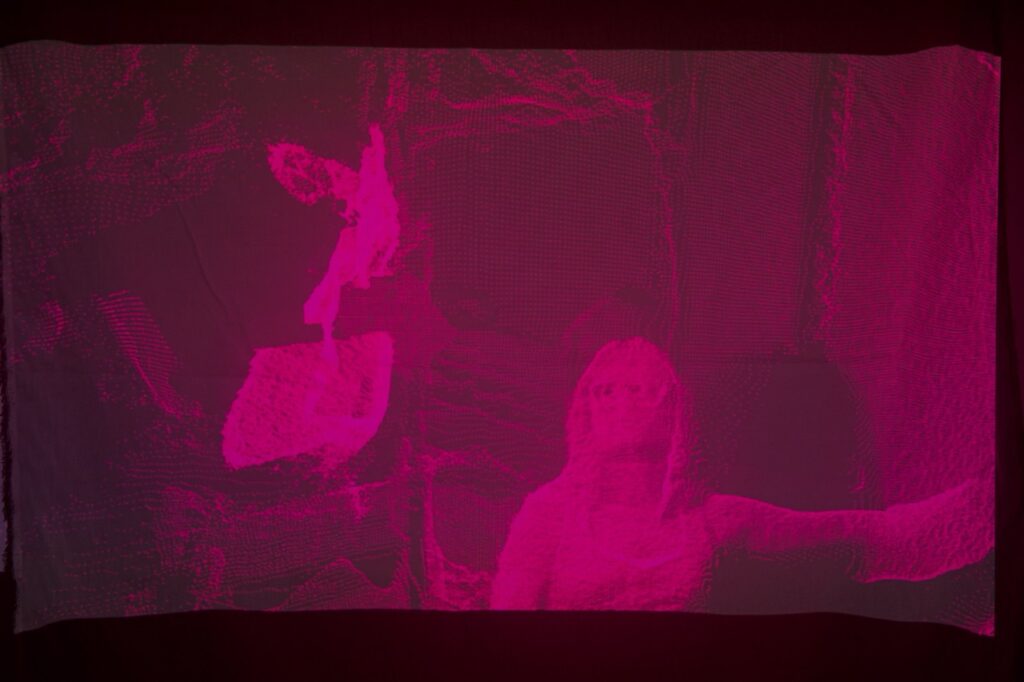aham brahmasmi
Aradhita Maheshwari
Advisor: Kari Love
The self is neither the body nor the mind, but something beyond – something felt in presence and absence, in movement and stillness. Through interactive and shifting visuals, this installation explores duality, negation, and the connection between self and something larger while inviting visitors to question: Who are we when everything familiar is stripped away?

Project Description
The concept of self is both universal and deeply personal—its meaning shaped by culture, memory, and belief. For me, this question is closely tied to the spiritual frameworks I grew up with, where gods, rituals, and morality offered early understandings of identity. But when we strip away external roles—our relationships, professions, histories—what remains? Who are we beneath it all?
This interactive installation is a multi-sensory exploration of selfhood through three distinct panels, each inspired by core ideas from Advaita Vedanta and Hindu mythology. The first invites participants to confront the absence of reflection, drawing from Neti Neti—a practice of negation that peels away layers of identity to reveal what cannot be named or seen. The second explores Shiva and Shakti, not as gendered deities, but as archetypes of dual forces within each of us—consciousness and energy, stillness and movement, presence and dynamism. The third panel culminates in the realization of Aham Brahmasmi—“I am Brahman”—a moment where the boundary between self and universe dissolves.
Through shifting visuals, symbolic forms, and ambient sound, the work creates a space where perception, presence, and absence are in constant dialogue. Rather than offering answers, it opens questions: What defines me when nothing mirrors me back? Can I feel whole in fragmentation? Can dissolution reveal unity?
This is not a linear journey, but a circular invitation—to lose the self, and perhaps, find something deeper.

Technical Details
This project was built through three core technical components — hardware, software, and physical form — all working in harmony to create an immersive exploration of selfhood.
At the heart of the system is TouchDesigner, a real-time visual programming environment that enabled dynamic visual manipulation based on user presence and interaction. Using Kinect v2, I captured depth and movement data, allowing the visuals to shift responsively with proximity — participants could engage with the panels simply by moving closer or further away. Arduino Uno and ultrasonic distance sensors were additionally used to support precise motion-based triggers.
Each interaction is layered with mythological symbols—like the Trishul, Om, and Lotus—transformed into point clouds and overlaid in real time. These visual abstractions were designed to mirror the conceptual depth of the work, blending ancient motifs with contemporary digital aesthetics.
The experience was set within a 6-meter-long white muslin fabric structure, suspended from the ceiling to create soft, tunnel-like corridors. The fabric holds symbolic weight: in Hindu rituals, white cloth marks both the beginning and end of life — used to wrap newborns as well as the deceased. It evokes themes of purity, surrender, and transcendence.
Complementing the visuals, two ambient audio layers played throughout — a flute (symbolizing divine calm and soul-calling) and a chant (looped in counts of 108, honoring its sacred Vedic significance).
Together, these components formed a spiritual, sensory field where technology, mythology, and the body converge.

Research/Context
Advaita Vedanta, one of the most profound schools of Hindu philosophy, forms the conceptual core of this project. Rooted in the ancient Vedas and Upanishads, it challenges the fundamental idea of separation—between self and other, body and spirit, individual and universe. Its central tenet, Aham Brahmasmi ("I am Brahman"), speaks to a realization that the self (Atman) is not distinct from the ultimate reality (Brahman). Rather than defining identity through accumulation—names, roles, memories—Advaita invites us to understand the self by shedding those very layers.
This philosophical inquiry became deeply personal for me after moving to New York City. In the midst of cultural shifts, distance from home, and a fast-moving world, I found myself quietly confronting questions of identity and belonging. The disorientation of relocation became a mirror—an opening to explore what truly remains when familiar definitions of self fall away. My search naturally turned inward, toward the stories, teachings, and symbols I grew up with—toward the spiritual frameworks that once shaped my understanding of the world.
In parallel, I drew from contemporary artists and immersive experiences that explore perception and the dissolution of ego—such as the infinite reflections of Yayoi Kusama or the disembodying light of James Turrell. These influences offered visual and spatial strategies for making the intangible feel momentarily visible.
This project is a synthesis of ancient wisdom and personal questioning, expressed through a sensorial, interactive medium that invites others into that same space of reflection.
